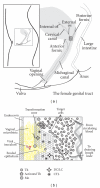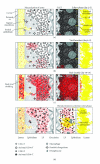The Microbiological Context of HIV Resistance: Vaginal Microbiota and Mucosal Inflammation at the Viral Point of Entry
- PMID: 22506135
- PMCID: PMC3312325
- DOI: 10.1155/2012/131243
The Microbiological Context of HIV Resistance: Vaginal Microbiota and Mucosal Inflammation at the Viral Point of Entry
Abstract
Immune activation is increasingly recognized as a critical element of HIV infection and pathogenesis, causing expansion of virus founder populations at the mucosal port of entry and eventual exhaustion of cellular immune effectors. HIV susceptibility is well known to be influenced by concurrent sexually transmitted infections; however, the role of commensal vaginal microbiota is poorly characterized. Bacterial vaginosis (BV) is a risk factor for HIV acquisition in studies worldwide; however, the etiology of BV remains enigmatic, and the mechanisms by which BV increases HIV susceptibility are not fully defined. A model of how vaginal microbiota influences HIV transmission is considered in the context of a well-established cohort of HIV-exposed seronegative (HESN) commercial sex workers (CSW) in Nairobi, Kenya, many of whom have increased levels of anti-inflammatory factors in vaginal secretions and reduced peripheral immune activation (immune quiescence). Elucidation of the relationship between complex microbial communities and inflammatory mucosal responses underlying HIV infection should be a priority for future prevention-focussed research.
Figures



References
-
- Gottlieb MS, Schroff R, Schanker HM. Pneumocystis carinii pneumonia and mucosal candidiasis in previously healthy homosexual men. Evidence of a new acquired cellular immunodeficiency. New England Journal of Medicine. 1981;305(24):1425–1431. - PubMed
-
- Kreiss JK, Koech D, Plummer FA. AIDS virus infection in Nairobi prostitutes. Spread of the epidemic to East Africa. New England Journal of Medicine. 1986;314(7):414–418. - PubMed
-
- Fowke KR, Nagelkerke NJD, Kimani J, et al. Resistance to HIV-1 infection among persistently seronegative prostitutes in Nairobi, Kenya. Lancet. 1996;348(9038):1347–1351. - PubMed
-
- Brenchley JM, Price DA, Douek DC. HIV disease: fallout from a mucosal catastrophe? Nature Immunology. 2006;7(3):235–239. - PubMed
LinkOut - more resources
Full Text Sources

